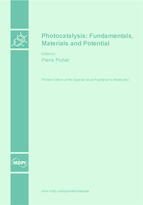Photocatalysis
A special issue of Molecules (ISSN 1420-3049). This special issue belongs to the section "Organic Chemistry".
Deadline for manuscript submissions: closed (15 August 2014) | Viewed by 301954
Special Issue Editor
Interests: heterogeneous photocatalysis; advanced oxidation processes; environmental chemistry; catalysis; photochemistry
Special Issues, Collections and Topics in MDPI journals
Special Issue Information
Dear Colleagues,
The field of heterogeneous photocatalysis has given rise to thousands of papers. Most often, these papers are dispersed in many journals. Consequently, from time to time, there is a need for a Special Issue to provide a broad survey and address the various aspects of this field. For the readers, this Special Issue will give an attractive opportunity to obtain, more easily, information concerning the different facets of heterogeneous photocatalysis. For the authors, it will be an appropriate occasion to make their results and analyses more visible, and to show that they are active members of the scientific community in heterogeneous photocatalysis. This Special Issue will contain contributions discussing all the aspects broadly indicated by the keywords. Reviews articles by experts in the field will also be welcome.
Dr. Pierre Pichat
Guest Editor
Manuscript Submission Information
Manuscripts should be submitted online at www.mdpi.com by registering and logging in to this website. Once you are registered, click here to go to the submission form. Manuscripts can be submitted until the deadline. All submissions that pass pre-check are peer-reviewed. Accepted papers will be published continuously in the journal (as soon as accepted) and will be listed together on the special issue website. Research articles, review articles as well as short communications are invited. For planned papers, a title and short abstract (about 100 words) can be sent to the Editorial Office for announcement on this website.
Submitted manuscripts should not have been published previously, nor be under consideration for publication elsewhere (except conference proceedings papers). All manuscripts are thoroughly refereed through a single-blind peer-review process. A guide for authors and other relevant information for submission of manuscripts is available on the Instructions for Authors page. Molecules is an international peer-reviewed open access semimonthly journal published by MDPI.
Please visit the Instructions for Authors page before submitting a manuscript. The Article Processing Charge (APC) for publication in this open access journal is 2700 CHF (Swiss Francs). Submitted papers should be well formatted and use good English. Authors may use MDPI's English editing service prior to publication or during author revisions.
Keywords
- fundamentals
- UV and visible-light sensitive photocatalysts/supports/composites
- reactors and modelling
- organic synthesis
- environmental potentialities and applications
- hydrogen and other fuels production
- testing methods
- comparisons with other processes







